Damian Lewis, Market Development Manager, Enterprise, at Inmarsat
A seismic shift is taking place across the energy industry. As the world becomes increasingly aware of the need to reduce our reliance on traditional methods of power generation to combat climate change, investment in the development of renewable energy sources is going from strength to strength.
This shift is paving the way for a transition to a more sustainable global energy system and is already having a significant impact on the agriculture sector in particular.
Distribution networks face significant change
One of the implications of this shift is a dramatic change to the existing electrical distribution network and the provider/consumer relationship. The move to renewable energy sources provides greater opportunities for households and commercial customers to generate power locally and operate semi-independent micro-grids.
The climate in Africa is particularly well suited to renewable energy generation via solar power and with recent advancements in Agrivoltaics[1] (solar systems mounted several meters above ground, allowing crops to grow underneath), it is now possible for farmers to generate renewable energy locally without having to sacrifice valuable land space.
Agriculture set to benefit
The ability to generate energy locally and operate their own semi-independent micro-grid offers farmers numerous benefits, including providing a more cost effective and reliable method to power vital farm processes, such as irrigation systems, etc. It also enables farmers to operate as an ‘island’ during interruptions in service from the central grid, providing improved resilience and continuity of power supply.
The move towards distributed energy generation (multiple local power sources contributing to a state or national grid) can also provide farmers with an additional revenue stream by offering them the chance to resell excess energy.
More widely, independently generated energy can be shared via local micro-grids to provide electricity to rural areas and help support the wider community. This could prove instrumental to ongoing development across the continent with less than 45% of Sub-Saharan Africa currently benefitting from access to electricity[2].
Smart tech and reliable connectivity are key
In order to create the most efficient network possible, smart grid technology and reliable connectivity are essential.
Particularly in cases where a micro-grid is connected to a state or national grid, smart tech and robust connectivity are often necessary to meet the requirements of their supervisory control and data acquisition systems (SCADA), as well as effectively managing the energy exchange process between them. Even though the data exchanges that take place on smart grids are often very small, they are absolutely mission critical, making reliable connectivity all the more vital to ensuring their successful operation.
Terrestrial connectivity, even in countries with good geographic network coverage, is often insufficiently reliable for this application, so for micro-grids operating in remote rural African regions finding robust connectivity can be even more challenging.
This is where global satellite connectivity, such as that provided by Inmarsat’s L-Band network, can ensure a highly reliable, cost-efficient solution. Inmarsat provides connectivity over its ELERA network using small, lightweight machine-to-machine devices able to endure exposure to harsh environments and providing a tried and tested solution for farmers.
As the energy sector continues to transition from traditional methods of power generation to renewable energy sources, we all have a part to play in supporting this global shift. Helpfully, for those able to do so with the right tools and support behind them, there are also significant opportunities to benefit individually and contribute to the development of the wider community along the way too.
[1] https://www.sheffield.ac.uk/sustainable-food/news/launching-east-africas-first-combined-solar-energy-and-agriculture-system
[2] https://data.worldbank.org/indicator/EG.ELC.ACCS.ZS?locations=ZG










[…] Credit: Source link […]
Comments are closed.